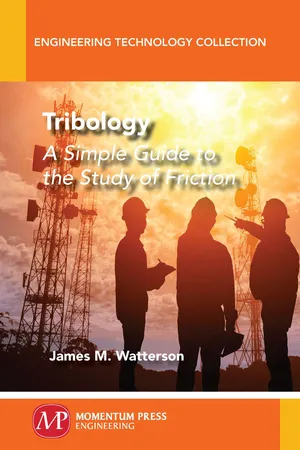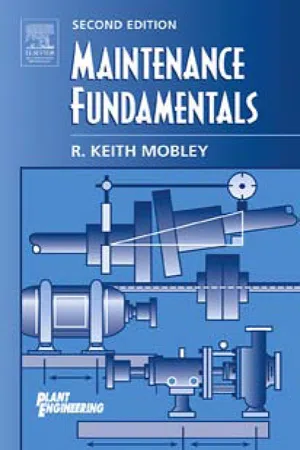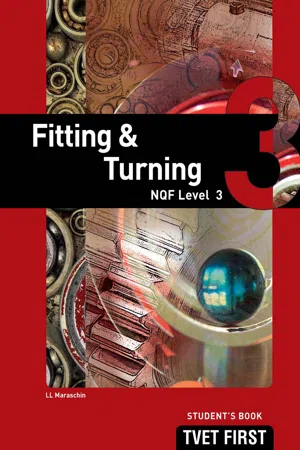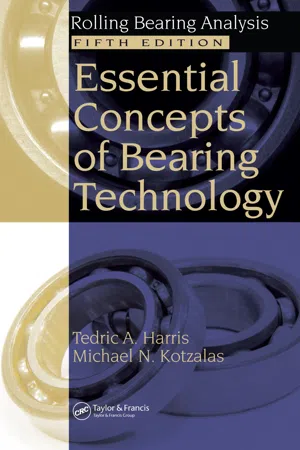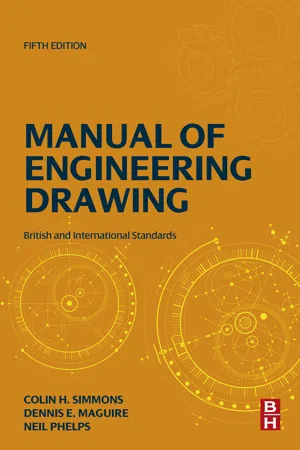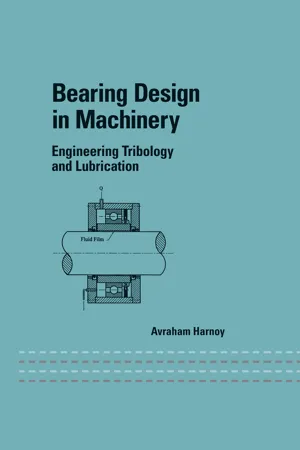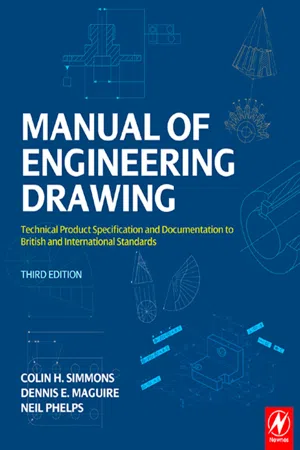Technology & Engineering
Bearings
Bearings are mechanical components that enable rotational or linear movement by reducing friction between moving parts. They are used in a wide range of applications, from machinery and vehicles to household appliances and industrial equipment. Bearings come in various types, including ball bearings, roller bearings, and plain bearings, each designed for specific load and speed requirements.
Written by Perlego with AI-assistance
Related key terms
1 of 5
11 Key excerpts on "Bearings"
- eBook - ePub
Tribology
A Simple Guide To The Study of Friction
- James M. Watterson(Author)
- 2019(Publication Date)
- Momentum Press(Publisher)
CHAPTER 2BEARINGSFUNCTION OF A BEARING
A bearing is a device that permits constrained relative motion between two parts, typically rotation or linear movement. Put simply, a bearing supports and constrains a rotating shaft or sliding element (linear motion) with a minimum loss of energy due to friction owing to its materials of construction. Common motions include linear/axial and rotary/radial.A linear bearing allows motion along a straight line. A rotary bearing or thrust bearing allows motion about a center, such as a wheel on an axle or a spindle through a housing. Common kinds of rotary motion include both one-direction rotation and oscillation where motion only goes through part of a revolution.Low-friction Bearings are often important for efficiency, to reduce wear and facilitate high speeds. Essentially, a bearing can reduce friction by virtue of its shape, by its material, or by introducing and containing a fluid between its surfaces.• By shape, gains advantage usually by using spheres or rollers.• By material, exploits the nature of the bearing material used (plastics or metal alloys).• By fluid, exploits the viscosity of a layer of fluid, such as a lubricant or as a pressurized medium to keep the two solid parts from touching.• By fields, exploits electromagnetic fields, such as magnetic field, to keep solid parts from touching.LOAD BEARING AND PERFORMANCE CAPACITIES
Vary greatly over the forces and speeds they can support. Forces can be radial, axial (thrust Bearings) or moments perpendicular to the main axis.The maximum speeds that rotational Bearings can support also vary; generally, performance is defined in terms of the product “DN” where D is the diameter (often in mm) of the bearing and N is the rotational speed in revolutions per minute.BEARING FRICTION
The torque required to put a bearing into motion from rest is usually higher than that required to keep the bearing running once it has started. Starting friction, therefore, has an important influence on the power required in a bearing drive system. - eBook - PDF
- R. Keith Mobley(Author)
- 2011(Publication Date)
- Butterworth-Heinemann(Publisher)
9 Bearings A bearing is a machine element that supports a part—such as a shaft—that rotates, slides, or oscillates in or on it. There are two broad classifications of Bearings, plain and rolling element (also called anti-friction). Plain Bearings are based on sliding motion made possible through the use of a lubricant. Anti-friction Bearings are based on rolling motion, which is made possible by balls or other types of rollers. In modern rotor systems operating at relatively high speeds and loads, the proper selection and design of the Bearings and bearing-support structure are key factors affecting system life. T YPES OF M OVEMENT The type of bearing used in a particular application is determined by the nature of the relative movement and other application constraints. Movement can be grouped into the following categories: rotation about a point, rotation about a line, translation along a line, rotation in a plane, and translation in a plane. These movements can be either continuous or oscillating. Although many Bearings perform more than one function, they can generally be classified based on types of movement, and there are three major classifications of both plain and rolling element Bearings: radial, thrust, and guide. Radial Bearings support loads that act radially and at right angles to the shaft center line. These loads may be visualized as radiating into or away from a center point like the spokes on a bicycle wheel. Thrust Bearings support or resist loads that act axially. These may be described as endwise loads that act parallel to the center line towards the ends of the shaft. This type of bearing prevents lengthwise or axial motion of a rotating shaft. 125 Guide Bearings support and align members having sliding or reciprocating motion. This type of bearing guides a machine element in its lengthwise motion, usually without rotation of the element. - eBook - PDF
Fitting & Turning NQF3 SB
TVET FIRST
- L Maraschin(Author)
- 2014(Publication Date)
- Macmillan(Publisher)
The main function of Bearings, however, is to reduce mechanical friction. Reducing friction: • helps machinery to run more efficiently • reduces frictional wear and extends the life of the machinery • prevents abrasive wear and reduces the incidence of mechanical breakdown. Bearings are divided into two groups, plain (sliding) Bearings and rolling element Bearings consisting of balls or rollers. Bearings are designed to accommodate radial or axial loads as well as a combination of both. Radial load Axial load Axial load Radial load Figure 2.2: Loads on Bearings Radial load Axial load Figure 2.3: Examples of radial and axial loads Did you know? The earliest Bearings were made from wood. An example is the wheels on the early horse-drawn coaches and on ox wagons. They were cooled by water if required. Abrasive wear: the action of a hard, sharp material cutting through or wearing down the surface of a softer material Radial: along the radius of the shaft Axial: along the axis of the shaft, i.e. its centreline Words & Terms Axial load Radial load 11 Module 2: Demonstrate an understanding of plain and anti-friction Bearings Unit 2.2: Identify the types of plain (sliding) Bearings The plain bearing is also referred to as a friction bearing or a sliding bearing and consists of two smooth surfaces which slide over each other, as opposed to having a rolling action. They are also loosely termed as journal or sleeve Bearings. Plain Bearings are cylindrical in shape and are mostly designed to carry radial loads. A sliding bearing needs a lubricating film in the clearance space between the shaft and the bearing bush. The oil is dragged into the wedge -shaped gap in the high-pressure region. This oil film supports the shaft and prevents metal-to-metal contact. To maintain the gap, oil may be supplied by means of a pump. The part of the shaft that is supported in the bearing is called the journal. - eBook - PDF
- Tedric A. Harris, Michael N. Kotzalas(Authors)
- 2006(Publication Date)
- CRC Press(Publisher)
Initially, this development was triggered by the bearing requirements for high-speed 1 aircraft gas turbines; however, competition between ball and roller bearing manufacturers for worldwide markets increased substantially during the 1970s, and this has served to provide consumers with low-cost, standard design Bearings of outstanding endurance. The term rolling Bearings includes all forms of Bearings that utilize the rolling action of balls or rollers to permit minimum friction, from the constrained motion of one body relative to another. Most rolling Bearings are employed to permit the rotation of a shaft relative to some fixed structure. Some rolling Bearings, however, permit translation, that is, relative linear motion, of a fixture in the direction provided by a stationary shaft, and a few rolling bearing designs permit a combination of relative linear and rotary motions between two bodies. This book is concerned primarily with the standardized forms of ball and roller Bearings that permit rotary motion between two machine elements. These Bearings will always include a complement of balls or rollers that maintain the shaft and a usually stationary supporting structure, frequently called a housing , in a radially or axially spaced–apart relationship. With the rollers used by the Assyrians to move massive stones in 1100 BC . . . The simple ball bearin g for 19th centur y bic y cles marked man’s first important victor y . and later, with crude cart wheels, man strived to overcome friction’s drag. FIGURE 1.1 The evolution of rolling Bearings. (Courtesy of SKF.) 2 Essential Concepts of Bearing Technology Usually, a bearing will be obtained as a unit that includes two steel rings, each of which has a hardened raceway on which hardened balls or rollers roll. The balls or rollers, also called rolling elements, are usually held in an angularly spaced relationship by a cage, whose function was anticipated by Leonardo. - eBook - PDF
Applied Engineering Technology NQF4 SB
TVET FIRST
- Sparrow Consulting(Author)
- 2013(Publication Date)
- Macmillan(Publisher)
Module 2 The operating principles of mechanical components used in the engineering-related design industries TO1 SO2: Explain the operating principles of mechanical components used in the engineering-related design industry Overview When you have completed this module, you will be able to: • identify and describe the use of plain Bearings (T1 SO2 LO1) • identify and describe the use of roller Bearings (T1 SO2 LO2) • identify and explain the working and the use of the five general classifications in pump technology (T1 SO2 LO3) • explain terminology related to pump technology (T1 SO2 LO4) • describe and explain the use of hydraulic and pneumatic valves (T1 SO2 LO5) • describe the reasons for the use of different drive transmissions (T1 SO2 LO6) • describe and explain the use of couplings (T1 SO2 LO7) • describe and explain the use of seals (T1 SO2 LO8) • explain the refrigeration cycle (T1 SO2 LO9) • explain the operation of a domestic refrigerator (T1 SO2 LO10). Unit 2 .1 Plain Bearings Unit outcomes By the end of this unit, you will be able to: • identify and describe the use of plain Bearings. Range: thick film lubricant, thin film lubricant, zero lubricant. Introduction A bearing is a machine part with a shaft or an axle that allows other parts to move or rotate. Bearings are devices that are used to prevent bearing: a machine part with a shaft or an axle that allows other parts to move or rotate shaft: a long round bar that transmits motion or power axle: a shaft that allows a wheel to rotate Words & Terms 18 Module 2: The operating principles of mechanical components used in the engineering-related design industries friction between two moving parts. Normally one part is stationary and the other is rotating . Bearings act as a support for rotating shafts. Bearings are classified by the type of movement or motion they allow and the direction of applied loads they can handle. We will discuss these loads in more detail in the following sections. - Barbara Renner(Author)
- 2017(Publication Date)
- CRC Press(Publisher)
CHAPTER 4 Bearings4.01 A bearing can be briefly described as a supporting surface that separates a stationary and a moving object. Generally, Bearings are thought of as something that supports a rotating shaft. However, this necessarily is not always the case. There are many applications that use sliding Bearings. A shutoff gate, for example, uses sliding Bearings to support the gate. The “ways” of a lathe or milling machine are also sliding Bearings. In addition, linear Bearings are used to support actuating rods that travel back and forth. This chapter, however, will consider the Bearings primarily used with rotating components.ROTATING COMPONENTS4.02 The rotating components in most water/wastewater treatment plants consist of shafting supported by Bearings at one or more places along the shaft. In some instances, such as centrifugal pumps and speed reducers, the Bearings that support the shaft are located within a frame or housing and are not visible. Whether the shafts are enclosed or exposed, they are subjected to the same kinds of loading and stress conditions (Figure 4.1 ):• bending • torque • axial Basically, shafting is subjected to one or more of these conditions at the same time.4.03 Bending is the most common shaft stress. Bending is the deflection of the shaft that is a result of the load that is applied to it. The head or driveshaft of a chain style collector in a primary settling tank is subjected to bending as a result of two different forces—the drive load and the weight of the chain and sprockets that move the flights. The Bearings are mounted near or at the ends of the shaft. The drive load is located outboard of one of the Bearings, whereas the driven load of the flights and their sprockets are mounted between the two Bearings.4.04- eBook - ePub
Manual of Engineering Drawing
British and International Standards
- Colin H. Simmons, Dennis E. Maguire, Neil Phelps(Authors)
- 2020(Publication Date)
- Butterworth-Heinemann(Publisher)
35Bearings and applied technology
Abstract
In a plain bearing, the relative motion is by sliding in contrast with the rolling motion of ball and roller Bearings. When surfaces rotate or slide, the rotational or sliding motion results in friction and heat. Energy is used, the surfaces wear, and this reduces component life and product efficiency. Friction may be reduced by lubrication which keeps the surfaces apart. At the same time, lubricants dissipate heat and maintain clean contact surfaces. Materials are carefully selected with appropriate mechanical and physical properties for Bearings and their housings, to minimize the effects of friction, and particular care is taken with the accuracy of machining, surface finish and maintenance of all component parts associated with Bearings. This chapter covers all types of Bearings from Plain to Ball and Roller to Thrust and includes good advice on bearing selection, materials, alignment, lubrication, loads, rigidity, speeds, mounting and dismounting, seals, application, and finally fits and tolerances.Keywords
Bearings; Ball; Roller; Needle; SealsWhen surfaces rotate or slide, the rotational or sliding motion results in friction and heat. Energy is used, the surfaces wear, and this reduces component life and product efficiency. Friction may be reduced by lubrication which keeps the surfaces apart. At the same time, lubricants dissipate heat and maintain clean contact surfaces. Materials are carefully selected with appropriate mechanical and physical properties for Bearings and their housings, to minimize the effects of friction, and particular care is taken with the accuracy of machining, surface finish and maintenance of all component parts associated with Bearings. - eBook - ePub
Bearing Design in Machinery
Engineering Tribology and Lubrication
- Avraham Harnoy(Author)
- 2002(Publication Date)
- CRC Press(Publisher)
1 Classification and Selection of Bearings 1.1 INTRODUCTION Moving parts in machinery involve relative sliding or rolling motion. Examples of relative motion are linear sliding motion, such as in machine tools, and rotation motion, such as in motor vehicle wheels. Most Bearings are used to support rotating shafts in machines. Rubbing of two bodies that are loaded by a normal force (in the direction normal to the contact area) generates energy losses by friction and wear. Appropriate bearing design can minimize friction and wear as well as early failure of machinery. The most important objectives of bearing design are to extend bearing life in machines, reduce friction energy losses and wear, and minimize maintenance expenses and downtime of machinery due to frequent bearing failure. In manufacturing plants, unexpected bearing failure often causes expensive loss of production. Moreover, in certain cases, such as in aircraft, there are very important safety considerations, and unexpected bearing failures must be prevented at any cost. During the past century, there has been an ever-increasing interest in the friction and wear characteristics of various bearing designs, lubricants, and materials for Bearings. This scientific discipline, named Tribology, is concerned with the friction, lubrication, and wear of interacting surfaces in relative motion. Several journals are dedicated to the publication of original research results on this subject, and several books have been published that survey the vast volume of research in tribology. The objectives of the basic research in tribology are similar to those of bearing design, focusing on the reduction of friction and wear. These efforts resulted in significant advances in bearing technology during the past century. This improvement is particularly in lubrication, bearing materials, and the introduction of rolling-element Bearings and Bearings supported by lubrication films - eBook - ePub
Manual of Engineering Drawing
Technical Product Specification and Documentation to British and International Standards
- Colin H. Simmons, Dennis E. Maguire(Authors)
- 2009(Publication Date)
- Butterworth-Heinemann(Publisher)
Chapter 32. Bearings and applied technology
When surfaces rotate or slide, the rotational or sliding motion results in friction and heat. Energy is used, the surfaces wear, and this reduces component life and product efficiency. Friction may be reduced by lubrication which keeps the surfaces apart. At the same time, lubricants dissipate heat and maintain clean contact surfaces. Materials are carefully selected with appropriate mechanical and physical properties for Bearings and their housings, to minimize the effects of friction, and particular care is taken with the accuracy of machining, surface finish and maintenance of all component parts associated with Bearings.In a plain bearing, the relative motion is by sliding in contrast with the rolling motion of ball and roller Bearings.Plain Bearings
Plain Bearings may be classified as follows:The bearing metal should have a low coefficient of sliding friction, be able to conduct heat generated away from the bearing surfaces, resist wear in use and be tough enough to withstand shock loading in service. In the event of breakdown due to lack of lubrication, it may be desirable when overheating occurs for the bearing material to run, preventing seizure and possible severe damage to associated mechanical parts.Direct-lined housings
These housings are lined directly with bearing materials and the choice of material is limited by the practicality of keying or bonding the bearing material to the housing surface.The dimensions of the housings, casting temperatures and bonding characteristics of the bearing materials will determine whether metallurgical bonding is possible without unacceptable distortion of the housing. Generally this technique is limited to ferrous housings with low-melting point whitemetal bearing surfaces. Light alloy and zinc base housings are difficult to line directly with whitemetal. - eBook - ePub
Manual of Engineering Drawing
Technical Product Specification and Documentation to British and International Standards
- Colin H. Simmons, Dennis E. Maguire(Authors)
- 2012(Publication Date)
- Butterworth-Heinemann(Publisher)
Chapter 35
Bearings and Applied Technology
When surfaces rotate or slide, the rotational or sliding motion results in friction and heat. Energy is used, the surfaces wear, and this reduces component life and product efficiency. Friction may be reduced by lubrication which keeps the surfaces apart. At the same time, lubricants dissipate heat and maintain clean contact surfaces. Materials are carefully selected with appropriate mechanical and physical properties for Bearings and their housings, to minimize the effects of friction, and particular care is taken with the accuracy of machining, surface finish and maintenance of all component parts associated with Bearings.In a plain bearing, the relative motion is by sliding in contrast with the rolling motion of ball and roller Bearings.Plain Bearings
Plain Bearings may be classified as follows :The bearing metal should have a low coefficient of sliding friction, be able to conduct heat generated away from the bearing surfaces, resist wear in use and be tough enough to withstand shock loading in service. In the event of breakdown due to lack of lubrication, it may be desirable when overheating occurs for the bearing material to run, preventing seizure and possible severe damage to associated mechanical parts.Direct-lined Housings
These housings are lined directly with bearing materials and the choice of material is limited by the practicality of keying or bonding the bearing material to the housing surface.The dimensions of the housings, casting temperatures and bonding characteristics of the bearing materials will determine whether metallurgical bonding is possible without unacceptable distortion of the housing. Generally this technique is limited to ferrous housings with low-melting point whitemetal bearing surfaces. Light alloy and zinc base housings are difficult to line directly with whitemetal. - eBook - ePub
- Ansel C. Ugural(Author)
- 2020(Publication Date)
- CRC Press(Publisher)
10 Bearings and Lubrication10.1 Introduction
The goal of a bearing is to provide relative positioning and rotational freedom while transmitting a load between two parts, commonly a shaft and its housing. The object of lubrication is to reduce the friction, wear, and heating between two surfaces moving relative to each other. This is done by inserting a substance, called a lubricant , between the moving surfaces. The study of lubrication and the design of Bearings are concerned mainly with phenomena related to the oil film between the moving parts. Note that tribology may be defined as the study of the lubrication, friction, and wear of moving or stationary parts. The literature on this complex subject is voluminous. Much is collected in the CRC Handbook of Lubrication , sponsored by the American Society of Lubrication Engineers [1 ]. Also see [2 ]. The website www.machinedesign.com includes general information on Bearings and lubrication.There are two parts in this chapter. In Part A, the fundamentals of lubrication with particular emphasis on the design of journal (the so-called sleeve or sliding) Bearings is discussed. The basic forms of journal Bearings are simple. In Part B, the concern is with rolling Bearings, also known as rolling-element Bearings , and anti-friction Bearings. We describe the most common types of rolling Bearings, bearing dimensions, bearing load, and bearing life. There is also a brief discussion on materials, mounting, and lubricants of rolling Bearings. Rolling-element Bearings are employed to transfer the main load through elements in rolling contact, and they have been brought to their present state of perfection only after a long period of development. Either ball Bearings or roller Bearings, they are made by all major bearing manufacturers worldwide.Part A: Lubrication and Journal Bearings
Journal Bearings support loads perpendicular to the shaft axis by pressure developed in the liquid. A journal bearing is a typical sliding bearing requiring sliding of the load-carrying member on its support. Sleeve thrust Bearings support loads in the direction of the shaft axis. We begin with a description of the lubrications and journal Bearings. The general relationship between film velocity rate, viscosity, coefficient of friction, and load is then developed. This is followed by discussions of the hydrodynamic lubrication theory, design, and heat balance of Bearings. Techniques for supplying oil to Bearings and bearing materials are also considered.
Index pages curate the most relevant extracts from our library of academic textbooks. They’ve been created using an in-house natural language model (NLM), each adding context and meaning to key research topics.
